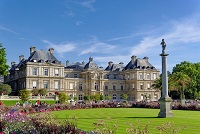How the French Government Works

France, officially known as the French Republic, is ruled according to the Constitution of the Fifth Republic, which came into force in 1958 under Charles de Gaulle (the First Republic was founded in 1792 after the Revolution). The laws of the current constitution, however, trace their roots back to the declaration of rights agreed during the French Revolution and then at the end of World War Two.
Until relatively recently, French government was extremely centralised, with most law and administration coming from the top. However in 1982 significant changes were introduced, giving power to local bodies, and this trend has continued to the present day.
Level One – the National Government
The head of state is the président, elected every five years by a majority vote during a general election. There are usually two rounds. If there is no clear majority winner after the first round of voting, a second is held a few weeks later.
The first round often sees as many as two dozen candidates from parties such as the Communists and Greens. The second round is usually between candidates from the two main political parties – les Républicains (LR, formerly known as UMP) and the Socialist Party (Parti Socialiste or PS).
According to the Constitution of the Fifth Republic, the president appoints the premier ministre as well as senior civil servants and military commanders. While the president plays a direct role in foreign policy, it is the Premiere Ministre who, in theory at least, appoints the government (conseil des ministres), guides government policy, and is the main driver of political reform.
At this level the government introduces legislation that covers policy on all major areas, from finance, health, and education, to housing, the environment, and defence.
Another complication to the relationship between the president and prime minister is that the président appoints the premier ministre from the parliamentary majority – this has meant that on a couple of occasions the president and the prime minister have come from different political parties. This was the case under centre-right Président Jacques Chirac, for example, who appointed socialist Lionel Jospin as Premier Ministre in 1997.
Parliament
France has a bicameral parliament (parlement) with two houses – the National Assembly (Assemblée nationale) and the Senate (Sénat).
The Assemblée Nationale is the lower house and consists of 577 members (called députés) who are elected by majority during one or two rounds (in a similar system to the presidential voting) in constituencies through the country. A constituency comprises 100,000 inhabitants or fewer. Each député serves a five-year term.
The premier ministre and Conseil des Ministres are responsible only to the Assemblée nationale. If the Assemblée nationale passes a motion of censure, or rejects a programme or declaration of policy, then the premier ministre must resign.
The Sénat is the upper house and consists of 349 seats – 326 for metropolitan France, 10 for overseas departments and territories and 12 for French nationals abroad. In the past senators (sénateurs) served for nine years, with new elections for one-third of the seats held every three years. However under the recent reform of the system they serve six years, with elections to renew half the seats held every three years.
Sénateurs are elected indirectly, by membership of representative bodies that include 150,000 locally elected officials such as mayors, city councillors and members of the Assemblée nationale. Historically it is the more conservative of the two houses.
The senateurs elect a Président of the Sénat as first in line in succession if the Président de la République dies, resigns, or is impeached.
The Sénat is a house of revision and advice, and while it can delay legislation it cannot veto it.
Level Two – Regions
Régions, whose authority falls between the national government and the départments, were introduced in 1982. Until 2015 there were 26 regions – 22 in metropolitan France and four overseas (the latter, however, have the powers of départments.) In January 2016 the number of regions is consolidated to reduce the total number to 13 regions.
Members of the regional council are elected for six years, and they oversee planning, regional town and country planning, economic development, vocational training and the building, equipment and running costs of lycées (high-schools). The regional council has a budget and they are directly responsible to the Treasury.
They are assisted by an economic and social committee, a consultative assembly made up of representatives of businesses, the professions, trade unions and other employees’ organisations, and regional voluntary organisations.
Level Three – Departments
France is divided into 101 départments, four of which are overseas. The most obvious sign of their identity is the two-digit number that is used for postcodes (the first two digits – for example 16 for Charente) and on vehicle licence plates.
Départments oversee health and social services, rural capital works, departmental roads, and the capital expenditure and running costs of colléges.
Napoleon created the role of the Préfet – someone appointed by the state and the sole person empowered to act on the behalf of the state, representing the prime minister and the government. They undertook this role until 1982 when their powers were modified.
Today, while the préfet still represents the state, executive authority has been handed over to the president of the General Council (conseil général) who implements the decisions of the council. The council is elected – each department is divided into cantons. France has 2054 cantons, which serve as the constituencies for the elections. Each councillor has a six-year term, with elections taking place every three years for half of them.
The préfet, however, remains a significant figure in the department, and is in charge of local police and fire-fighters and is responsible for road safety, the provision of driving licences, and identity cards.
Level Four – Communes
Almost everyone comes in contact with the fourth and lowest tier of the French administrative hierarchy. There are almost 36,700 communes in France, with 80% of them having fewer than 1,000 residents.
Voters elect a municipal council every six years, and the council elects its chief executive, in this case the mayor (maire). The mayor is also considered a representative of the government.
The maire and the municipal council propose and implement the municipal budget and ensure the conservation and management of the commune’s natural environment including issues over heritage and building permits. Maires are also responsible for security and public health and have at their disposal the municipal administration.
As the representative of the state, the maire is the registrar of births, marriages, and deaths and is an officer of the police judiciaire and so entitled to exercise special powers in connection with the repression of crime under the authority of the public prosecutor. The mayor also publicises laws and draws up the electoral register.
And Finally… intercommunality
The basic form of intercommunality is the communauté de communes, a federation of municipalities geographically adjacent to each other. Another form of intercommunal organisation is the pays. A pays is an area with common geographical, economic, cultural, or social interests and which has entered into a communal planning contract, more of a forum for discussion and setting objectives, rather than a formal governmental body as it has no budgetary or law-making powers.
•With thanks to Rachel Loos
Share to: Facebook Twitter LinkedIn Email
More in businesses, charente, education, finance, guides, legal, renovation
Leave a reply
Your email address will not be published. Required fields are marked *



